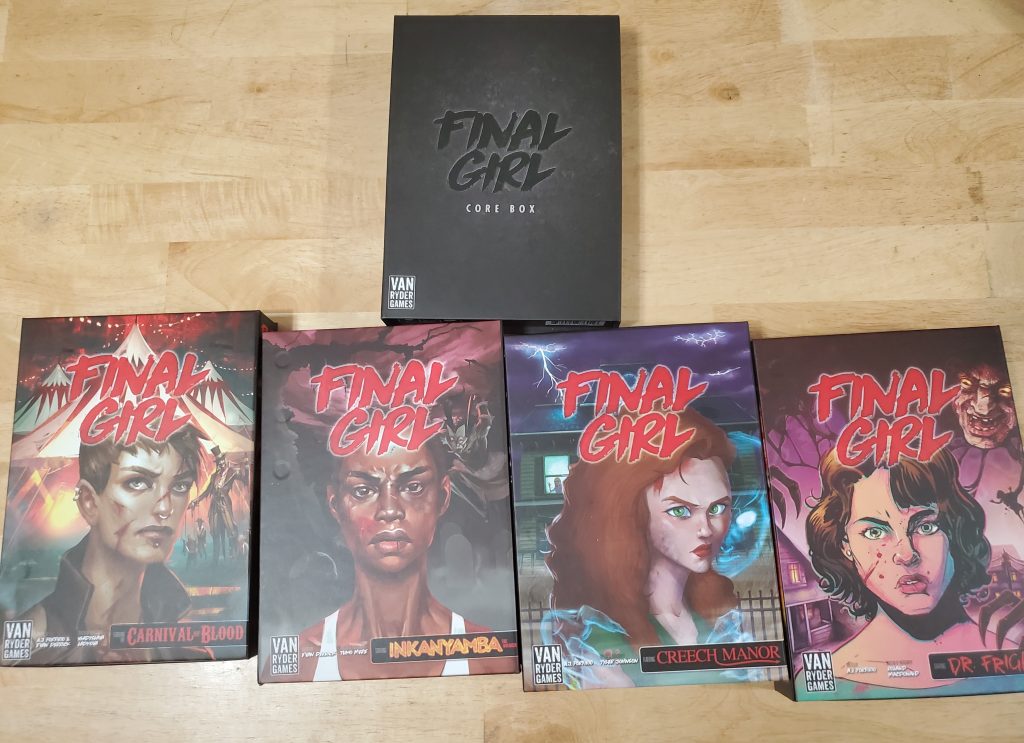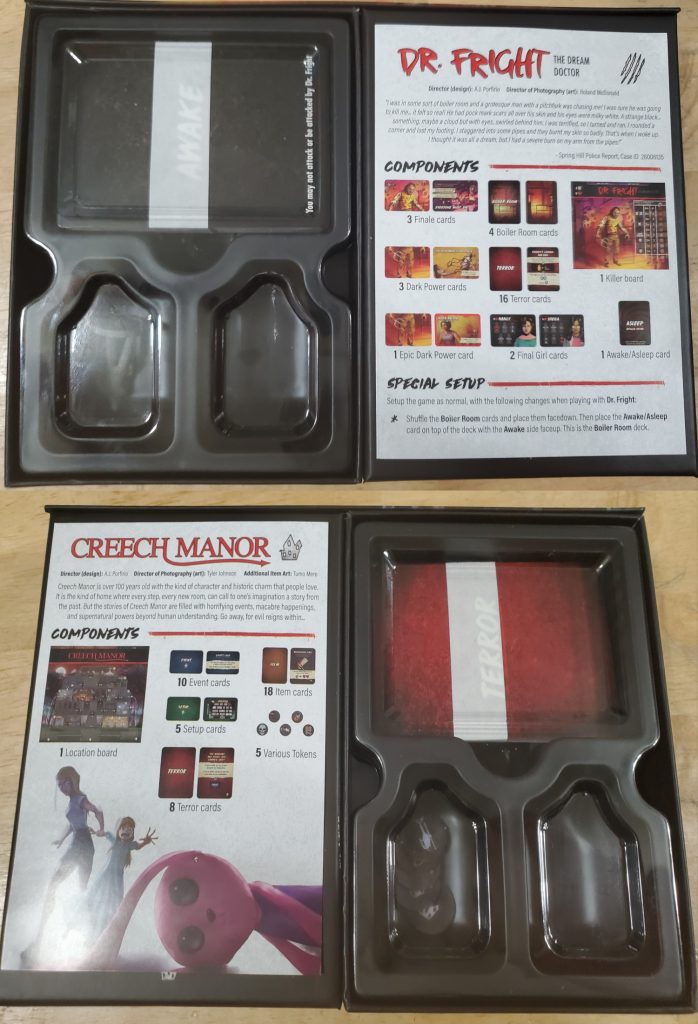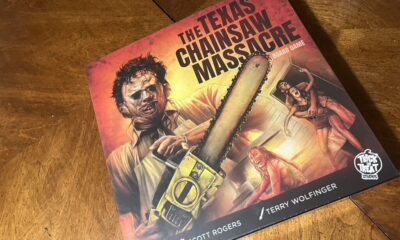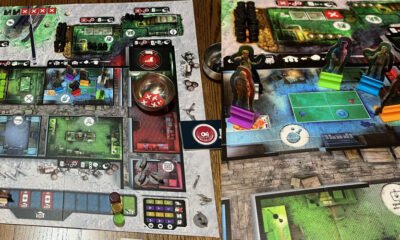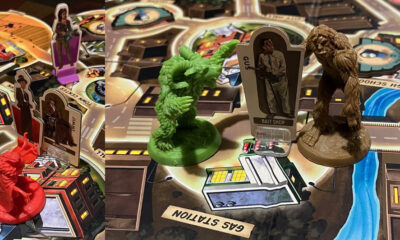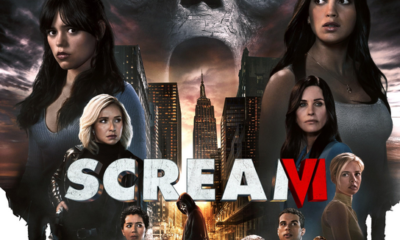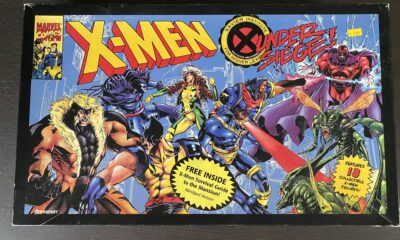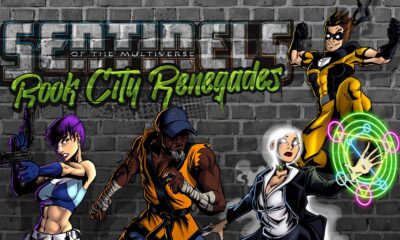
Final Girl
More Videos
Published
2 years agoon
By
Leather Snow
Final girl is a single-player modular board game from Van Ryder Games where you take the role of a final girl as you fight to take down a fierce killer. I saw it at the game store and was immediately reminded of games like Dead by Daylight, Sentinels of the Multiverse, and Horrified, so I had to give it a try.
Components
The core box comes with 1 double-sided board, the rulebook, 6 dice, 23 action cards, 11 health tokens, 25 health markers (these are different things), 8 tracking tokens, 1 bloodlust marker, 1 time marker, 27 victim meeples (3 of which are special victims), 3 victim holding boards and 3 victim holding tokens.
Feature film boxes vary, but they generally contain 2 game boards, one for the killer and one for the location, along with a rule sheet for each. Killer items usually include 4 dark power cards, 3 finale cards, 16 terror cards, and any other odds and ends needed for their particular gimmick. Location items generally are 5 setup cards, 10 even cards, roughly 15-20 item cards, 8 terror cards, and whatever tokens and such are needed for its gimmick. They also include 2 final girls and 2 secret envelopes with an item card specific to each girl.
I’m torn on the modular concept. On one hand it’s financially not that big of a deal, since buying a film box and a core box would be about the same price as buying a standard board game. At the same time, it’s kinda frustrating to buy something you can’t use without something else. It would’ve made a lot of sense to, at the very least, just shrinkwrap a feature film box along with the core box as a bundle.
The core box is for the most part well organized. I admittedly had to look up how to sort everything on the BoardGameGeek forums, but once I figured it out, everything fit in pretty neatly. I do still have a couple of complaints, though. The generally agreed upon section where you keep the dice is a bit too small. It’s a little difficult getting them out and putting them back in. There’s one other section you could put them in, but that one’s a bit too big, and I’m using that to keep the secret envelopes. The secret envelopes themselves are a little too bulky to fit in the main card area, so it made more sense to me to put them in their own spot.
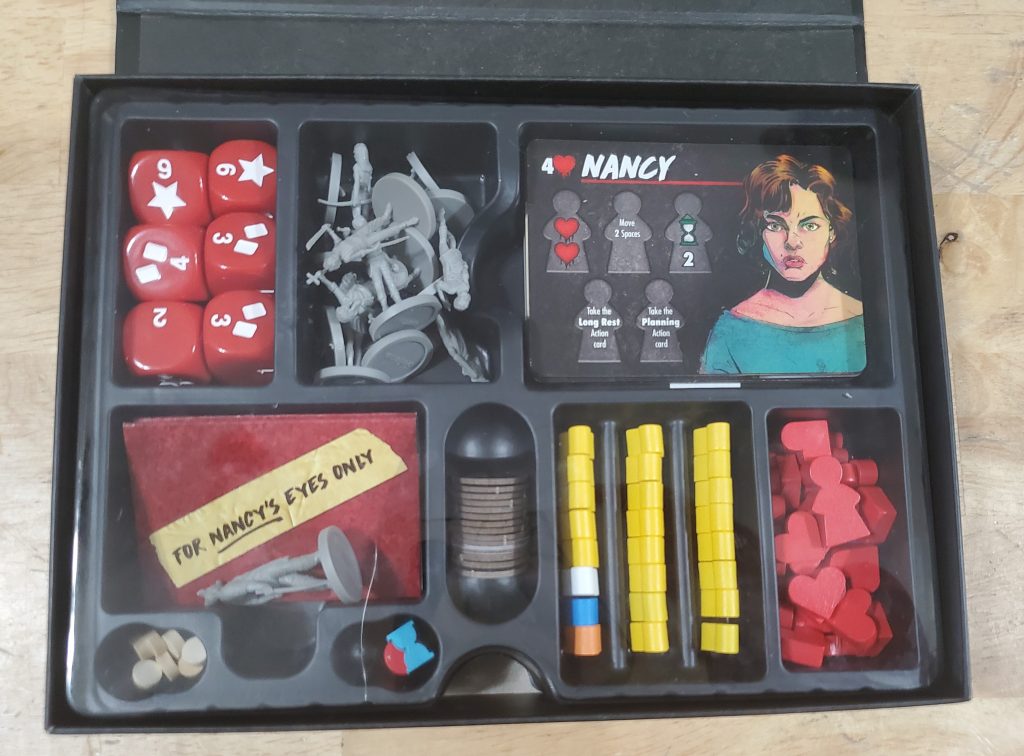
The feature film boxes, on the other hand, are a hot mess. The inserts are standardized, which is understandable, but they’re standardized in a way that doesn’t work well for any of them. There’s a section for cards and two sections for tokens and such. None of the feature film boxess I own have a need for that second small section, even with the extra mini pack. For the Slaughter in the Groves box, there are cards that just have to lay on top of the insert with the rules because they don’t fit. The rules are loosely laid on top of the inserts so they could be easily lost or damaged. I’ve also seen it mentioned on the Board Game Geek forums that the card sections are too small to hold sleeved cards.
Gameplay
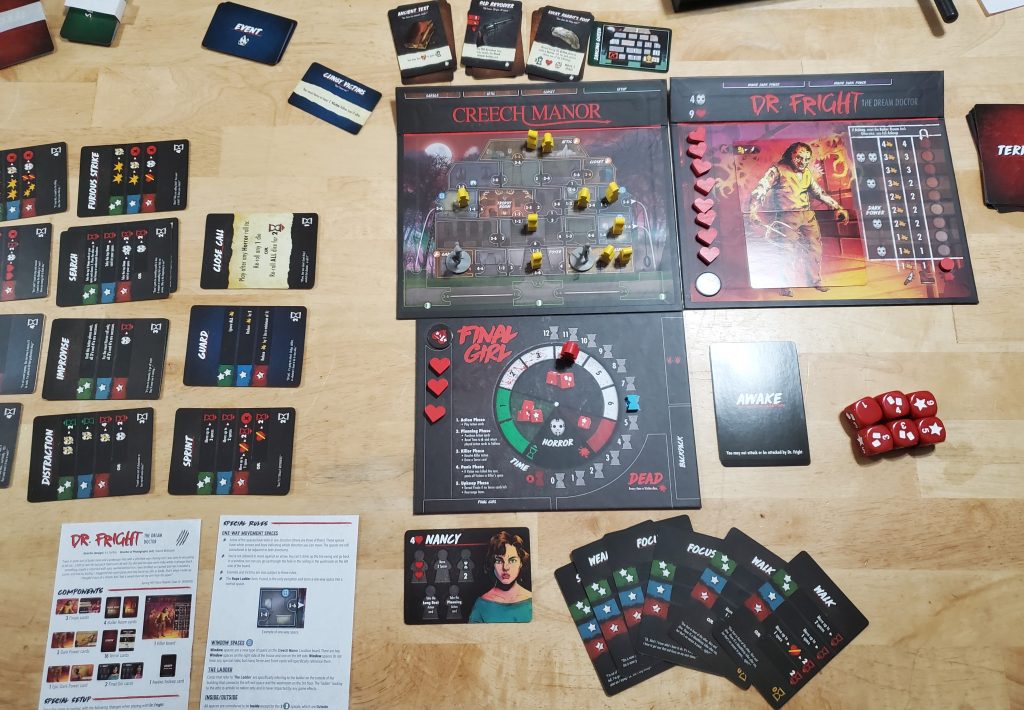
The game consists of 5 phases. The game begins with the action phase. You start with a hand of 10 cards, which allow you to do things like move, fight, and heal. You can play as many cards as you like until you decide to stop or you run out of time, and you can always discard a card to gain more time. Next is the planning phase, where you can buy action cards with time. At the end, your time resets to 6 and any cards you’ve played or discarded since the end of the last planning phase go back in the tableau for you to purchase again later. Then it’s time for the killer to act. The killer (and their minions) will perform their specific action, then you’ll reveal a terror card. If any victims die, any other victims in the same space as them will panic in the next phase. For each panicking victim, roll a die and move them to a new space based on the number rolled. After all that’s handled, move into the upkeep phase. Usually not much happens in this phase, but if you revealed the last terror card in the deck during the killer phase, this is when you reveal the killer’s finale card. Play continues until you or the killer are dead. As an added twist, your and the killer’s last health point is special. If it would be lost, you instead flip the token. It could be blank or it could give back a small amount of health.
Thoughts
The make or break aspect for most people will be that this is a single player game. Some people specifically like board games as a social activity, and have no interest in playing one by themselves, which is perfectly fine. While this game is fun, if you’re someone who doesn’t find the concept of a single-player board game appealing, I don’t think this is the game that will convince you otherwise.
Setting this game up can be draining. It gets easier the more you do it, but there are still so many steps and so many pieces that it can get a little tiring, especially considering each location and killer has special setup rules you have to factor in along with regular setup.
One of the bigger problems of the feature film setup is that since each killer has a particular gimmick, and there’s no bare-bones boilerplate killer included with the core rules, it can be harder to learn the game. I’ve heard that Hans from the Camp Happy Trails set is more along the lines of that basic killer I was looking for, but that was the one box I couldn’t get ahold of (aside from the vignette) so I can’t personally confirm this. Some of the specialized killers were harder to understand. For instance, we had a hard time figuring out how Dr. Fright is supposed to attack you and victims. His killer action does not include movement, so does he just stand there and do nothing? He can attack you from anywhere while you’re asleep during the boiler room phase, what about any other time while you’re asleep? And how does this all effect victims?
This game can be very difficult. Random chance can really screw you over. In one game in the Carnival of Blood location, on turn 1 the terror card made all victims panic, then killed all of them in or adjacent to a certain space. This killed about 5 victims, skyrocketing the killer’s bloodlust to almost maximum. The spirit killer has a similar terror card that kills 5 victims or does 5 damage to you. I understand this is probably meant to ratchet up the tension and keep the game from going on too long, but the game is already pretty short. You only use 10 cards to make the killer’s terror deck, and when you run out of terror cards you reveal the finale, which is a new, often brutal killer power and a more powerful killer action, which does a pretty good job of speeding up the end of the game. This difficulty issue can make the game setup feel worse; it just feels kinda bad to go through all this setup for a game that’s over very quickly mainly because you had bad luck.
Full disclosure, this might be an issue of me simply “playing wrong,” but items generally feel pointless. Weapons can be really helpful sometimes, but with how much effort it is to get items, it almost never feels worth it to try and get any of them. A lot of items are one-time use for a modest effect, and many are very situational. The item decks all start with the top card face up, which is helpful in gauging whether or not you should bother with items that game, but after that top card is gone, you don’t get to see what you’re searching for anymore. Unless you’re in a scenario where you absolutely need a specific item to win (aka you’re fighting poltergeist) or all the victims are dead/saved and you’re really desperate, blindly searching for items is rarely worth your already limited time.
To be clear, the game is still fun. It’s fun to plan things out multiple turns ahead, and fun to successfully execute those plans. If you, like me, enjoy resource management, managing your time and actions in this game is enjoyable. It’s also fun to figure out a way to course-correct when something goes horribly wrong. While it can suck to get beat down, clawing your way back from what feels like certain defeat can be really satisfying.
Verdict
I give this game three and a half out of five cthulhus. It’s pretty fun, but it can be really exhausting between the lengthy setup and at times grueling difficulty. S2 is currently on Kickstarter if you want to check it out.

You may like
-
Texas Chainsaw Massacre Board Game: A Chilling Adventure from Trick or Treat Studios
-
The Thing in Review, Movie 1, Movie 2 and the Board Game
-
Horrified Again! American Monsters Edition Review
-
Scream VI
-
X-Men Under Siege Review: Vintage Comic Weird
-
A Review of SotM Rook City Renegades: Definitive Edition
Gaming
Stygian: Reign of the Old Ones (2019), a Game Review
Stygian: Reign of the Old Ones (2019) is a tactical role-playing video game developed by Cultic Games, evoking Lovecraftian horror.
Published
3 months agoon
April 30, 2024
Stygian: Reign of the Old Ones (2019) is a tactical role-playing video game developed by Cultic Games, evoking Lovecraftian and cosmic horror. Published by Fulqrum Publishing, this game is available through Linux, macOS, and Windows. This review will cover the $19.99 Steam release.
The Great Old Ones have awakened, exiling Arkham after the events of Black Day. Design your character and face the abominations of Arkham. Explore the 1920s through a Lovecraftian aesthetic as you unravel the secrets that plague Arkham, facing unknowable cosmic horror and malicious abominations.
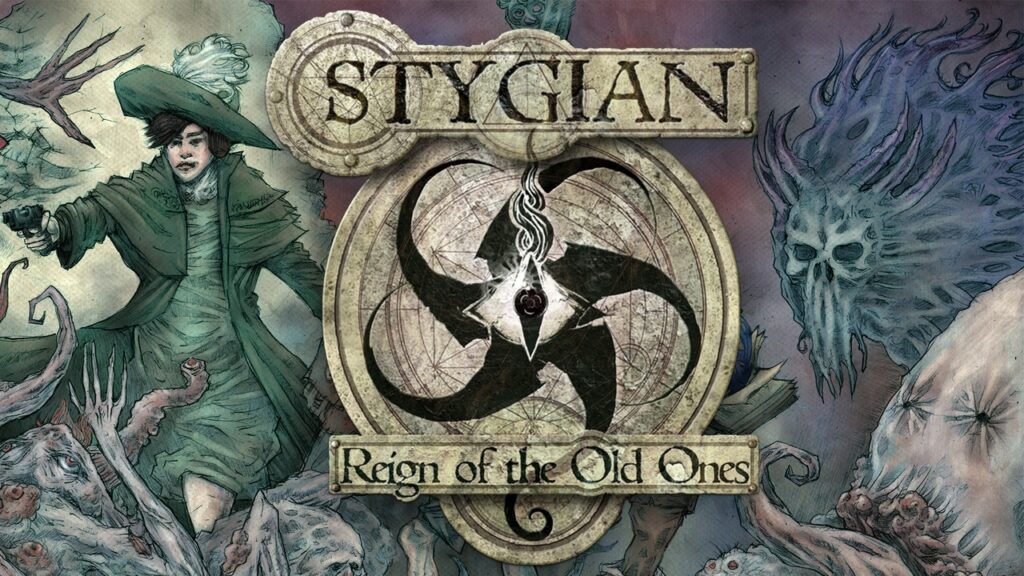
What I Like Stygian: Reign of the Old Ones
The depth of character creation starts the game off on the right foot. While appearance has various options, the game provides greater variety in motives, age, and origins, adding different gameplay elements. For example, age reflects lived experience and physical competency. The younger your character, the less experienced but more physically capable. This dynamic requires trial and error to find the best choice for you.
The paper cutout art provides a unique interpretation of a familiar (but stylish) Lovecraftian aesthetic. While not the most haunting execution of the Lovecraftian, it still manages to unsettle and unnerve while maintaining visual interest. That said, if the style doesn’t suit the player’s taste, Stygian: Reign of the Old Ones might leave that player wanting.
While I find the story engaging and the mysteries worth exploring, there’s a massive caveat to that claim. Regardless, if you fancy the Lovecraftian, few care as deeply and express as much knowledge of the genre as Cultic Games in this installment. This love and knowledge shines through in the often subtle allusions and references to the expanded universe. It may earn its place as the most Lovecraftian game out there.
The characters vary in interest and likability, but there’s usually something about them to add to the overall mystery. Naturally, this remains most evident in the companions that accompany the player on their journey.
In terms of horror, Stygian: Reign of the Old Ones achieves notable success. Despite the subjective points of aesthetics, the game brings out the most unsettling and uncomfortable elements of Lovecraftian and cosmic horror.

Tropes, Triggers, and Considerations
With an understanding of the Lovecraftian comes the question of how to deal with racism. Most properties try to remove this context, but Stygian: Reign of the Old Ones recognizes the text and era (the 1920s) with caricatures such as a lunatic in blackface. I won’t say it fully explores these toxic elements, but it’s not painted in a positive light.
Insanity and mental illness play a large role in the mechanics of the game, such as becoming a key component of casting spells. Loosely related, drug addiction and usage are mechanics with varying degrees of necessity depending on your build.
If these are deal breakers, perhaps give Stygian: Reign of the Old Ones a skip.
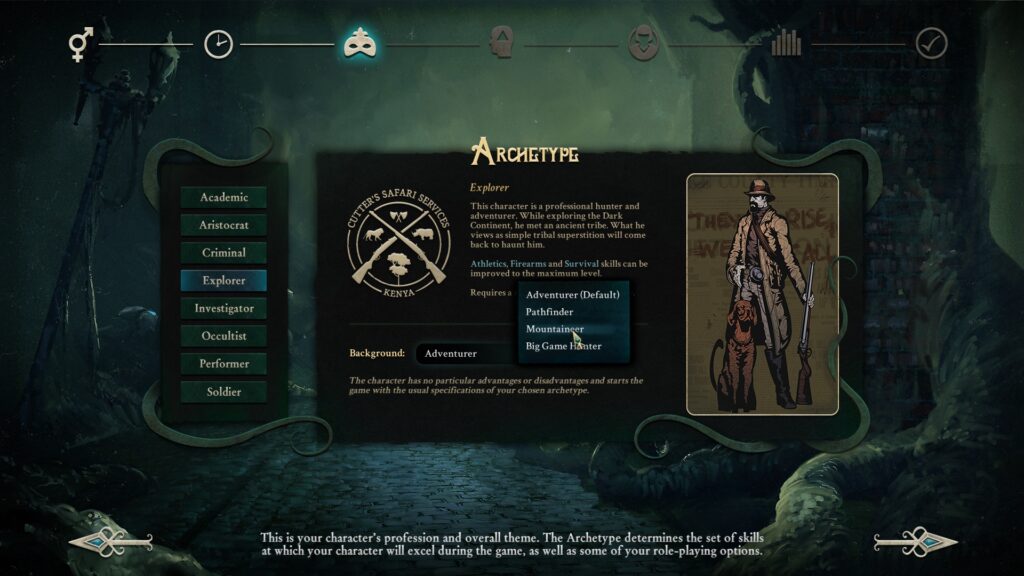
What I Dislike about Stygian: Reign of the Old Ones
In terms of story, this game is unfinished, leaving many plots, quests, and arcs with unsatisfying cliffhangers. My understanding is that Cultic Games planned to finish the game, but money ran out, and the focus shifted to an upcoming prequel. I imagine the goal is to use this new game to support a continuation. But that doesn’t change the unfinished state of Stygian: Reign of the Old Ones. The beginning and middle remain filled with content, but the final act (loosely stated) falls monstrously short.
While this unfinished state mostly affects content, I did run into game-breaking bugs. From my understanding, these bugs completely hinder progress. Most are avoidable, but some are unlucky draws.
It’s these points that make this a challenge to recommend, requiring the potential player’s careful consideration.
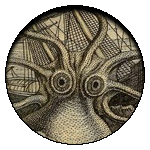
Final Thoughts
Stygian: Reign of the Old Ones accomplishes what many games fail, bringing to life the Lovecraftian. Unfortunately, this game falls short at the end and leaves game-breaking bugs as potential deterrents for full enjoyment. If what you read above entices you, it may be worth the investment. However, it’s unfair to recommend this game within its compromised state.
Gaming
Ashen (2018), a Game Review
Ashen (2018) is a souls-like action RPG developed by A44 and published by Annapurna Interactive available across all platforms.
Published
3 months agoon
April 30, 2024
Ashen (2018) is a souls-like action RPG game developed by A44 and published by Annapurna Interactive. This game provides a single-player and multiplayer experience with passive multiplayer mechanics. For this review, I am discussing the 39.99 Steam release, but it’s also available in the Epic Game Store, Xbox, Nintendo Switch, and PlayStation.
In this bitter world, your character seeks to make a home for yourself and others. This goal requires you to fight for every inch of land, building connections and alliances to maintain a thriving village. Venture further to make the world a more hospitable place, but know the further you travel, the greater the threats.
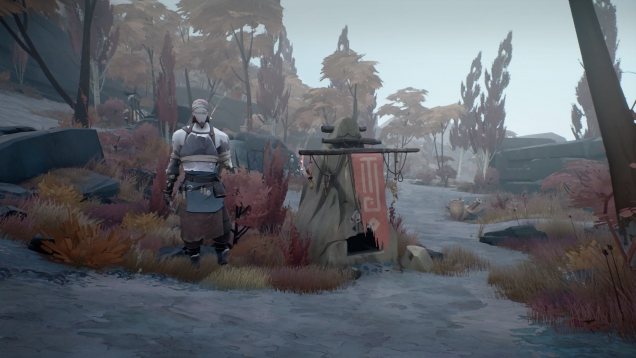
What I Like about Ashen
In 2017, Ashen earned a nomination for the Game Critics Awards’ “Best Independent Game.” It would later earn several more nominations in 2019. At the National Academy of Video Game Trade Reviewers Awards, it received nominations for “Game, Original Role Playing” and “Original Light Mix Score, New IP.” It was nominated for “Most Promising New Intellectual Property” at the SXSW Gaming Awards. Finally, at the Golden Joystick Awards, it earned a nomination for “Xbox Game of the Year.”
The multiplayer experience remains essential for Ashen, focusing on you and a partner venturing together to explore an open-world environment. However, the single-player experience is my focus and the game accounts for this gameplay. Ashen often pairs you with a villager who helps with the challenges.
The art style remains a plus throughout the gameplay. Though muted in colors and lacking finer details, the style creates a unique world that allows players to get lost along their journey. If the aesthetic doesn’t evoke that curiosity, then Ashen becomes hard to recommend.
Vagrant’s Rest and the inhabitants remain a strong incentive to continue on your journey. Seeing the progression of the town and building connections with the people provide the most rewarding experience.
In terms of horror, the art style often evokes an eerie atmosphere. However, I won’t go so far as to say the game is haunting. Instead, it evokes emotions that can unsettle and unnerve the gamer.

Thoughts and Considerations
The souls-like influence remains straightforward. Progression requires the player to defeat enemies and collect currency for weapons or certain item upgrades. Ashen simplifies and focuses its gameplay, reducing variety to polish its choices. The gameplay remains fluid, with a few hiccups that might be a computer issue.
If you prefer magic or defined classes, the gameplay doesn’t enable this variety. Item upgrades and choices define your playstyle, allowing most items to be playable at any stage of gameplay.
Weapons make a greater difference in playstyle. Most of these differences are self-evident (i.e. blunt weapons are slower but stun), but upgrades make any weapon viable. You pick an aesthetic and function, sticking with it until something better catches your eye.
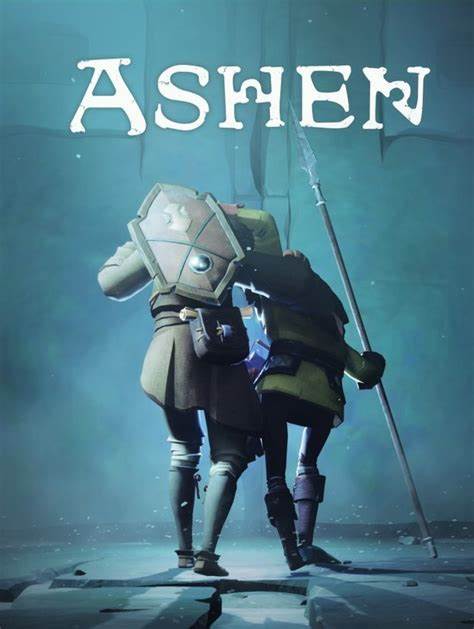
What I Dislike about Ashen
As mentioned, the game had some technical issues. I often assume this to be my computer, but I did note a few others mentioning similar issues. The gameplay remains fluid, so take this comment as a small point of consideration.
With limited roleplay options, liking the characters or art style remains essential for your time and money investment. As mentioned, the game doesn’t hold the variety of FromSoftware, which means their selling point comes from that unique art style and world.
Passive multiplayer is a major part of the marketing for Ashen. While I don’t mind this mechanic, 6 years after release reduces the overall impact. When so few wanderers appear in your game, it’s hard to see the overall appeal.

Final Thoughts
Ashen delivers a highly specialized souls-like experience, preferring to perfect what it can at the cost of variety. If the art appeals and the thirst for a souls-like has you wanting, Ashen stands as a strong contender. However, there are many contenders which make this hard to overtly recommend.
Gaming
I Have No Mouth, and I Must Scream (1995), a Game Review
I Have No Mouth, and I Must Scream (1995) is a point-and-click horror game based on Harlan Ellison’s award-winning short story.
Published
3 months agoon
April 29, 2024
I Have No Mouth, and I Must Scream (1995) is a point-and-click horror game based on Harlan Ellison’s award-winning short story of the same name. Developed by Cyberdreams and The Dreamers Guild, this adaptation brings a new perspective to a familiar story. I heard of free purchasing opportunities for this game but cannot verify the quality. For this review, I played the 5.99 Steam release.
Play as one of the remaining humans on earth: Gorrister, Benny, Ellen, Nimdok, and Ted. Each faces a unique challenge from their common torturer, the AI supercomputer known as AM. Chosen by AM to endure torment, these challenges require the participants to face their greatest failures and tragedies.
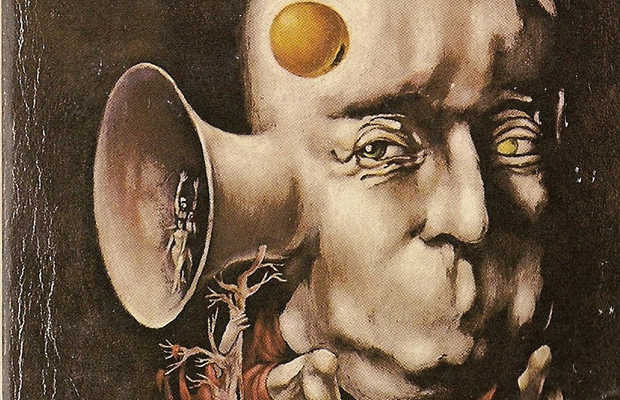
What I like about I Have No Mouth, and I Must Scream
Having experienced this story a few times, Harlan Ellison provides the most substantive execution of his vision and moral questions in this game. While all have individual merits, I assume the added content and context better dive into the relevant points he hoped to explore. He also played the voice of AM, giving us the emotional complexity of the machine as he saw it.
As the above comment indicates, I Have No Mouth, and I Must Scream remains a faithful adaptation with only one notable change. While that one change does reflect in that character’s journey, it uses that opportunity to the fullest. Where the short story left room for potentially inaccurate interpretations of the characters, this added context makes us better understand them.
The game’s writing remains a selling point for this story-driven experience. It dives further into the lore of the human characters and even allows further development of AM in the process. There are many ways to progress, and the multiple characters allow gamers to adventure further if stuck. That said, progressing individual characters to complete their journey remains essential for the true ending and experience.
As a point-and-click game made in 1995, I Have No Mouth, and I Must Scream holds up well. In many ways, it pushed the genre in its time with dynamic storytelling and game features. Harlan Ellison was someone who pushed boundaries to challenge himself and others. He saw the gaming industry as another opportunity to evoke story-driven art, a focus reflected here.

Thoughts, Triggers, and Considerations
I Have No Mouth, and I Must Scream adapts a dark and bleak story from an author notorious for his dark material. This game is no exception to that standard. Mental illness, sexual assault, genocide, and torture envelop the game. These elements are handled with attention but remain triggering to those sensitive to such dark material.
If these are deal breakers, I Have No Mouth, and I Must Scream will likely earn a skip.
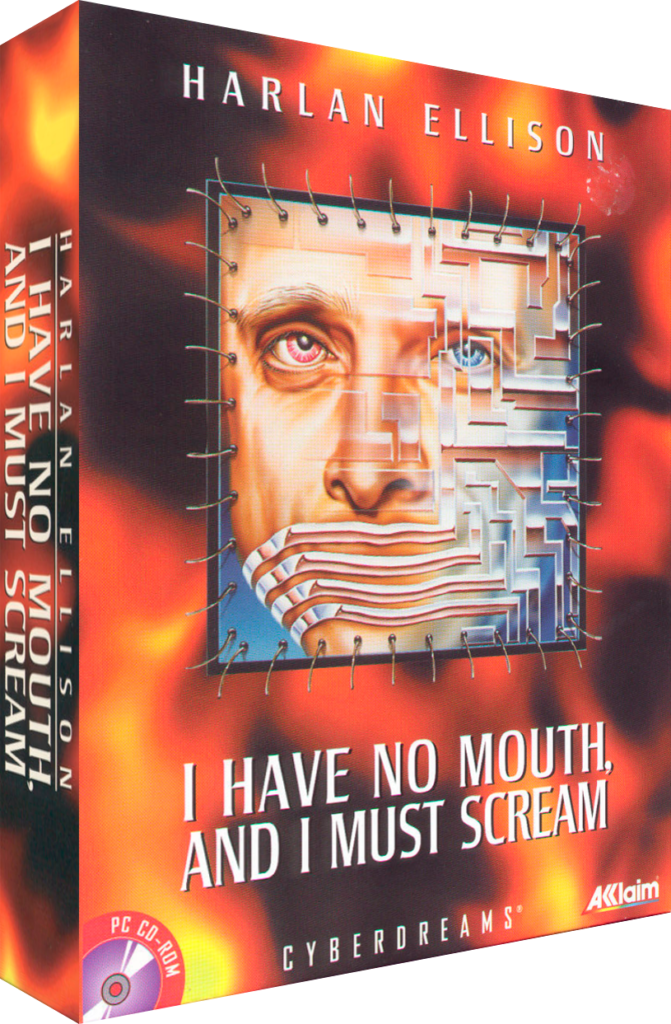
What I Dislike, or Considerations, for I Have No Mouth, and I Must Scream
While the short story remains a haunting example of fiction in every sentence, I Have No Mouth, and I Must Scream doesn’t evoke the same tension. It allows room to breathe or refocus on another character, which reduces the horror such a story evokes. While the characters participate in their torment, the loss of agency and hopelessness doesn’t translate in the execution.
Some mechanical and gameplay issues are noteworthy. For example, the saving mechanic remains dated, piling up if you save often or for specific reasons. Most of the mechanical issues stem from outdated UI from a gamer of a more modern era. Play it long enough, and elements start to click, but it needs that user investment.
Point-and-click caters to a niche audience, so modern gaming audiences aren’t inherently the demographic. The puzzle-solving and gameplay won’t win you over if the genre isn’t to your taste. Even within the genre, many of the puzzles remain challenging. For fans of the genre, this likely earns a positive merit. For those looking to continue the short story, this challenge will prove an obstacle.

Final Thoughts
I Have No Mouth, and I Must Scream provides a new opportunity for the award-winning story to reach new audiences and continue to grow. Not satisfied with repeating his story in a new medium, Harlan Ellison expands this bleak world through the point-and-click game. While not as haunting as the short story, this game provides the most context and development of any adaptation before it.


